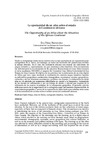Identificador persistente para citar o vincular este elemento:
https://accedacris.ulpgc.es/jspui/handle/10553/12818
| Campo DC | Valor | idioma |
|---|---|---|
| dc.contributor.author | Pérez Hernández, Eva | en_US |
| dc.date.accessioned | 2015-02-14T03:30:40Z | - |
| dc.date.accessioned | 2018-03-15T14:28:56Z | - |
| dc.date.available | 2015-02-14T03:30:40Z | - |
| dc.date.available | 2018-03-15T14:28:56Z | - |
| dc.date.issued | 2014 | en_US |
| dc.identifier.issn | 1133-598X | en_US |
| dc.identifier.other | WoS | - |
| dc.identifier.uri | https://accedacris.ulpgc.es/handle/10553/12818 | - |
| dc.description.abstract | Desde la Antigüedad clásica hasta nuestros días se han multiplicado las representaciones cartográficas de la Tierra, sin embargo, no todos los territorios del planeta han recibido la misma atención. En el caso del continente africano son escasas las colecciones de mapas recientes y, especialmente, las que conforman atlas temáticos. Esta circunstancia fue determinante en la orientación de las prácticas desarrolladas en Casa África durante el curso académico 2012-2013, al amparo del Consorcio Casa África-Universidad de Las Palmas de Gran Canaria. El objetivo de las prácticas fue la elaboración de un atlas digital de África que tuvo como resultado la realización de cuarenta mapas temáticos basados en indicadores geográficos, ambientales, demográficos, económicos, sociales, geopolíticos, culturales y de sus relaciones económicas y políticas con España. La elaboración de dicho atlas se vio afectada por numerosas dificultades en cuanto a la búsqueda y tratamiento de las fuentes de información y por un trabajo de diseño y edición que requirió de la utilización de las nuevas tecnologías de la información geográfica. El presente artículo reflexiona acerca de la importancia de la cartografía como herramienta imprescindible de conocimiento geográfico y acerca de la superación de dificultades que entrañan retos como el de la realización de un atlas sobre el estado actual del continente africano. | en_US |
| dc.description.abstract | From Classical Antiquity to the present days, cartographic representations of the Earth have multiplied. However, not all the territories of the planet have received the same attention. In the case of the African continent, there are few collections of recent maps, especially, of those that are composed of thematic atlases. This circumstance was decisive in determining the focus of the internship in Casa África during academic year 2012-2013, under the auspices of the Consortium Casa África - University of Las Palmas de Gran Canaria. The objective of the internship was the drawing up of a digital atlas of Africa, which resulted in the carrying out forty thematic maps based on geographical, environmental, demographic, economic, social, geopolitical and cultural indicators, as well as on its economic and political relations with Spain. The drawing up of this atlas was affected by many difficulties related to the searching and processing of the sources of information, as well as by a design and editing work that required the use of new geographical information technologies. This article reflects the importance of Cartography as an essential tool of geographical knowledge and the overcoming of that challenging difficulties such as the drawing up of an atlas about the present conditions of the African continent | en_US |
| dc.format | - | |
| dc.language | spa | en_US |
| dc.relation.ispartof | Vegueta: Anuario de la Facultad de Geografía e Historia | en_US |
| dc.source | Vegueta [ISSN 1133-598X], n. 14, p. 135-154, (2014) | en_US |
| dc.subject | 250502 Cartografía geográfica | en_US |
| dc.subject.other | Mapas | en_US |
| dc.subject.other | Map | en_US |
| dc.subject.other | Atlas | en_US |
| dc.subject.other | Thematic Cartography | en_US |
| dc.subject.other | Casa Africa | en_US |
| dc.subject.other | Atlas de África | en_US |
| dc.subject.other | Cartografía temática | en_US |
| dc.title | La oportunidad de un atlas sobre el estado del continente africano | en_US |
| dc.title.alternative | The Opportunity of an Atlas about the Situation of the African Continent | en_US |
| dc.type | info:eu-repo/semantics/article | en_US |
| dc.type | Article | en_US |
| dc.identifier.isi | 000218531500006 | - |
| dc.compliance.driver | 1 | - |
| dc.identifier.absysnet | 234500 | - |
| dc.identifier.eissn | 2341-1112 | - |
| dc.description.lastpage | 154 | en_US |
| dc.identifier.issue | 14 | - |
| dc.description.firstpage | 135 | en_US |
| dc.investigacion | Artes y Humanidades | en_US |
| dc.rights.accessrights | info:eu-repo/semantics/openAccess | - |
| dc.type2 | Artículo | en_US |
| dc.contributor.daisngid | 7258929 | - |
| dc.description.numberofpages | 20 | en_US |
| dc.utils.revision | Sí | en_US |
| dc.contributor.wosstandard | WOS:Hernandez, EP | - |
| dc.date.coverdate | 2014 | en_US |
| dc.identifier.ulpgc | Sí | en_US |
| dc.description.esci | ESCI | |
| dc.description.dialnetimpact | 0,0 | |
| dc.description.dialnetq | Q4 | |
| dc.description.erihplus | ERIH PLUS | |
| item.fulltext | Con texto completo | - |
| item.grantfulltext | open | - |
| crisitem.author.fullName | Pérez Hernández, Eva | - |
| Colección: | Artículos Vegueta. n.14, 2014 | |
Citas de WEB OF SCIENCETM
Citations
1
actualizado el 25-feb-2024
Visitas
187
actualizado el 01-mar-2025
Descargas
510
actualizado el 01-mar-2025
Google ScholarTM
Verifica
Comparte
Exporta metadatos
Los elementos en ULPGC accedaCRIS están protegidos por derechos de autor con todos los derechos reservados, a menos que se indique lo contrario.
